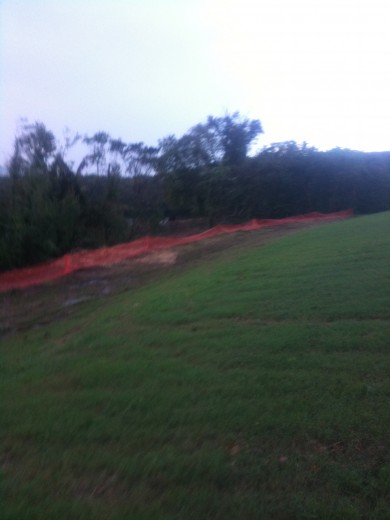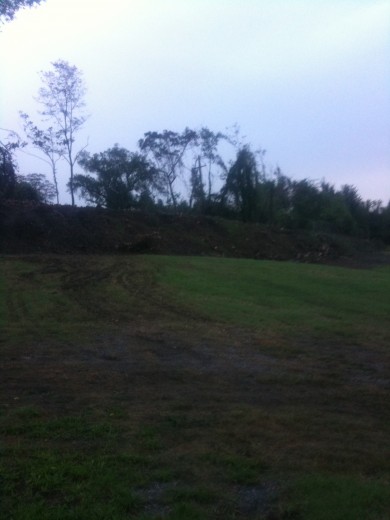I received this message last night:
I just learned that NewMarket has proceeded to dig along the canal in the proposed amphitheatre location and has damaged the wall. But it’s their property and they are, as you pointed out, determined to ruin the canal once and for all.
Click here for some background on this.
I woke up early and checked it out- looks like something is happening (one picture is from above the canal, one is from below):



The Kanawha Canal is an important piece of Richmond’s
past & future. Great Thanks to everyone on the team in the
Parks Department & the City who have worked so long to
protect the canal. You have done your best to fulfill our duty
to the future.
Because the canal has been a reality in one stage or another
since the visionary work of George Washington in 1785,
Richmond has worked carefully for centuries to prevent
disruption of the infrastructure that served a crucial function
in pre-fossil-fuel-dependent times.
Civilization’s cycle of turning is rendering more recognition
of the cost-effectiveness of rail (the canal’s main competitor
on the way forward in the growth of the national economy).
Eventually there will also be the recognition of the even
greater affordability of refurbishing & using the canal.
Small entrepreneurial use of the waterway was always
a growth engine of the common people’s layer of the local
economy. It will be again during retraction from the
illusion of limitless growth on a finite planet. Intensive
re-employment of navigable water travel is not likely to
be a reality in my lifetime, although many readers may
well see it (r)evolving as Americans adapt to the new norms
of post-Hubbert’s Peak.
Surely, in Virginia antiquity terms, we owe it to history
not to be the ones who to destroy the continuity of the
Kanawha Canal. In environmentalist perspective, we owe
it to the climate to do what we can now to provide for
long-term (non-coal-car) alternatives for ordinary people
& goods having to make their local trips past the Falls of
the James.
One main purpose of the mid-town to mid-river greenway
is to use it as a transportation alternative when we inevitably
enter extenuating urban circumstances, when more residents,
students & visitors to Richmond walk, bicycle & boat about.
Pleasant amenities like an amphitheatre must be designed
to not rule out a brilliant & historic blueway to travel upstream
beyond Belle Isle & the Hollywood Rapids.
Planning for the canal might be a question of whether the
chicken or the egg comes first. At first the canal might seem
to be mostly for tourist boats up to Maymont & an extension
of the history tour on the canal downstream; then someday
the larger culture will see the benefit of & begin to use
“water taxi” for transporting commuters downtown or to
Shockoe Slip, & eventually it may be functionally necessary
again to affordable commercial forms of traffic moving up
the river. Navigable water is wisely being mapped with a
future-focused eye on the value as real-estate to the state
& municipalities, with the movement to open & protect
blue-ways hoping to keep a cap on the scale of expansion
or commercialization that would exclude ordinary public
access. Re-opening the canal must also be designed within
the context of supporting conservation easements to prevent
sale of any segments of James River Park.
We might say to ourselves that little canal would have to
be expanded to carry significant traffic anymore, yet we
must also look at it as it is: an existing, human-scale
option that we protect with foresight now while we have
resources, in preparation for the time that the canal would
be pressed into use exactly *because* of lack of the kinds
of massive infrastructure project resources that we in our
extraordinary times are temporarily fortunate enough to
consider ordinary.
Never happen? “Never” ends with our passing, & then our
progeny will live in a new world that we have only read about
in history, when life goes on without everything being based
on cheap, accessible oil. What can we leave our grandchildren’s
grandchildren to buffer the insult of our belief that the world
will end with us if it cannot continue our wastrel ways? How
’bout we leave them the awesome living American history of
the Kanawha Canal?
An alternative headline: “Local Companies Cooperate to Provide Faster Commute Times, Reduce Traffic Congestion and Carbon Footprints for Workers and Park Goers.”
Citizens have raised concerns about what exactly this means for local traffic. More speeders on Idlewood coming off expressway would not be a good thing.
It’ll ease congestion for those traveling north on the Lee Bridge down 2nd Street up to Byrd St. The new road will essentially be a U-turn from the exit ramp from the Lee Bridge straight down to Tredegar; And they’ll avoid Byrd and 5th Street altogether. Other people using the Downtown Expressway that work down on Tredagar Street most likely get off at the 3rd Street exit and not on the Belvidiere exit which takes them down Idlewood. Commuters avoid two traffic lights by getting off at 3rd Street.
Thank you Scott for posting these photos…I saw that they already tore through the trees and brush down to the bones to reveal the canal. I was wondering if any environmental impact statement is necessary by the city or otherwise when construction concerns tearing into an ecological structure that looks like wetlands. This environment has been here growing undisturbed for who knows how many decades…fauna, animals have made this their home. Not to sound hoky. This matter should be looked into by the city before they construct a concrete byway and destroy what is there or may be in the process of being destroyed.
I also wonder how this is going to look to all of the attendees at the Folk Festival. I doubt people will rise up in praise of such an offensive degradation of this beautiful space. I think i may print out some info and pass it out at the location this weekend ;)